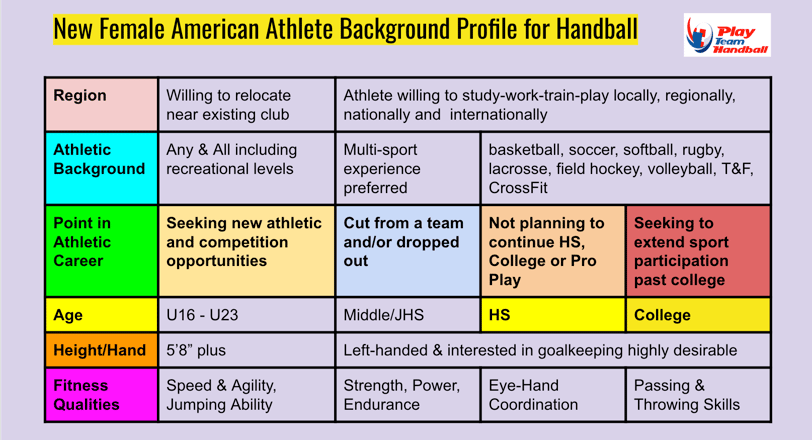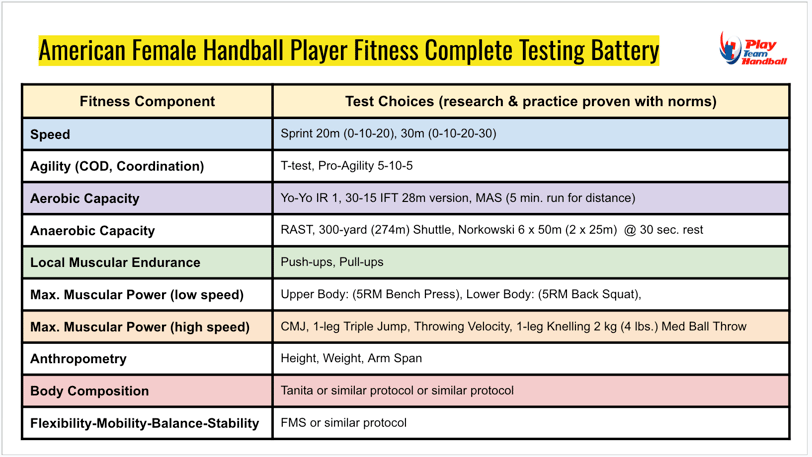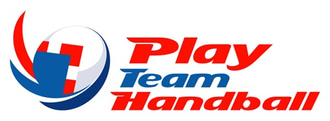Future Female American Handball Player Background & Fitness Profile - Raising Standards for the USATH WNT Pool Players
This installment clearly defines and describes a desirable background profile of new prospective female American handball player. Also, it proposes a comprehensive list of fitness qualities and corresponding strength & conditioning tests that could be used to evaluate: (1) a new recruit's aptitude for playing handball on the high level and (2) all NT pool eligible players’ level of conditioning for selection and training improvement purposes.
Mariusz Wartalowicz, Ph.D., CSCS
3/6/20257 min read


My simple and flexible model includes (1) a new recruit’s residence region/location, (2) sought after athletic background, (3) point is athletic career, (4) age, (5) height and handedness, and (6) desirable general fitness qualities that can be further developed and refined to meet the demands of the modern handball game.
All newly recruited athletes residing stateside and meeting NT basic criteria have to either live or be willing to relocate near an existing team/club that practices at minimum twice a week throughout the season (September through May). Recruiting even the best talent does not make any sense if we can’t provide sound on-going coaching instruction. Such instruction is only possible via local handball teams or clubs. So called development camps will not suffice either. Those weekend long events, in the best case scenario, can serve as an intro to our sport and general aptitude evaluation opportunity. Since we do not have either a semi- or a full-time residency program, prospective new players to make any technical-tactical progress towards achieving basic skill proficiency must not only train/play on the court with a team regularly but even more importantly be taught the ABCs correctly from the beginning. I can’t stress more enough the importance of early quality coaching in putting those prospects on the path to succeed. It is so difficult, if not impossible, to correct later those early poor technical and tactical skills/habits acquired during those initial formative months/years.
Historically, until around 2004, we had best past results in recruiting new female athletes to handball from basketball, softball, and soccer with each of those athletic backgrounds bringing very unique transition/adaptation challenges and opportunities. Since then, we have been struggling not only to attract but also retain high profile collegiate or post-college athletes. And, we had never been able to recruit, train, and mature HS athletes except a short period of time between 2008-2010 when Kathy Rex and Greg Morava (both Olympians) launched the Futures program mirroring the USA Field Hockey youth grassroots initiatives. The reasons for our dismal recruiting efforts are abundant. Yet, I will mention, not in any particular order, only a few here: no recruiting and handball aptitude evaluation methodology, nobody specifically charged and held accountable for recruiting new players, nothing to offer except the chance to represent the country in the infrequent international competitions, no long term competitive calendar, no long-term athlete development program, no strength and conditioning program or training guidelines, no annual training periodization, frequent WNT staff changes, failing to qualify for Pan Am Games, World Championships, Olympic Games, unsuccessful residency program in Auburn, bare bone pre-competition training opportunities, and very limited budget equalling often to pay-to-play model. I would say that today it really does not matter what sports those new athletes would come from as long as they actually are identified, evaluated, engaged, guided, supported, required to meet basic fitness and skill benchmarks to create at least some competition for those future roster spots. Presently, at best we have in the US a total of 80-100 active US born and raised female handball players across all age categories. It would be ideal if the new candidates had some previous multi-sport experience on at least a recreational level and strong self-motivation to excel in our sport. For now, we can forget about recruiting prominent players from the NCAA or NJCAA because, as the NGB or WNT, we do not meet even the basic organizational and performance criteria to reach out to those athletes and their parents. Instead we should focus our recruiting efforts less on an athlete’s former discipline and achieved level and more on her reasoning to give handball a serious consideration such as those for I listed in Table 1 under point in the athletic career category.
Age of new recruits is of importance and preferably, at least through this Olympic cycle, we would be successful in expanding our WNT pool with athletes 16-23 years old which would translate to mid HS, collegiate level or recent college graduates. On the elite handball level, height is a significant performance factor in both offense and defense, and based on widely available research world top teams players’ height is currently 5’9”± 2.6”. Thus, our internal preferable height benchmark could be set for 5’7” - 5’8” with an understanding that the height would be considered as one of several other recruiting tangible (i.e., motor skills) as well as intangible criteria like coachability, analytic mental or decision making, anticipatory skills. To become competitive again, even in our North American region, we also need to build depth on each position but especially goalkeeper, right backcourt and right wing positions. Therefore, we have to intensify search for left-handed athletes and those coming from goaltending backgrounds or wanting to make a transition to the goal as a primary position. New prospective players should exhibit baseline athletic potential giving us a reasonable belief that over time we can develop, refine it further, and bring it to the level prerequisite to meet modern handball demands.
In Table 2 below, I list a full list of fitness parameters and testing choices that should be considered during recruiting, evaluation, training, and selection processes. Efficacy of all proposed physical tests is supported by current sport science research. Some of those fitness tests are more general in nature while others are handball specific conditioning but all are used in practice by many leading handball nations to assess their players acute and/or longitudinal strength and conditioning status. There is normative data available for top class female handball players, including position specific norms that can be used as a comparative assessment tool.
We have been struggling in the US for many decades to attract new female athletes to handball. There are many reasons for this very unfortunate situation and I will mention a few key causes later on. However, the purposes of this piece are twofold. First, help potential new recruits as well as our coaches, both on the National Team and club level, with clearly defining and describing a general desirable background profile of those candidates. And second, propose a comprehensive battery of strength & conditioning tests that could be used to evaluate: (a) a new recruit's aptitude for playing handball on the high level as well as (b) our NT pool players’ level of conditioning for selection purposes.
Table 1 presents, based on research and practical experience, my personal take on the desirable background for new US born and raised female handball players.


Of course, at the beginning, we could start with a simple battery consisting of 3-5 tests where most of those measurements ought to serve as a point of reference for an athlete's long-term improvement plan. However, once an athlete becomes eligible for selection to our National Teams, regular comprehensive testing must become mandatory with very clear benchmarks (norms) set for each age category and specific court position. Concurrently to testing our pool players’ physical fitness level, we have to set and monitor basic individual technical-tactical skill requirements. Most of our NT players are predictable one-dimensional performers who in offense rely on a set of single pass-faint-shot and in defense on pure aggressiveness not aimed at winning the ball back. Currently, we do not have or make NT candidates adhere to any strength and conditioning standards which has been close to disastrous for the senior team’s international performance in recent years. Regretfully so, our NT players can’t physically withstand even 20 minutes of high intensity intermittent game of handball. The very same extremely poor physical conditioning has been negatively impacting execution of their significantly limited technical and tactical tasks. Technically and tactically, both in offense and defense, we are inferior on all fronts but especially we lag in individual offensive and defensive skill development that is a foundation for executing any tactical group/team strategies. We make a lot of unforced technical errors that allow our opponents frequent fast-break opportunities. We lack tactical discipline and do not show any strategic coherence neither in positional play, counterattack, fast throw off, nor in defensive formations. In defense we struggle in the most elementary 1 vs. 1 and 2 vs. 2 situations with pivots in-between causing chaos, misunderstandings between adjacent players and GK, easy breakthroughs for backcourt players and passes to line players. In defensive retreat we are slow and unorganized. We lack depth on the bench to rotate players through which would allow us to maintain pace of attack and defensive discipline. Only solid bright spot is in the goal where a veteran player has been holding her own for the last 12 years. I believe the few numbers from the 1st half of the game vs. Greenland contested during the 2023 2023 Nor.Ca Championships will suffice to support my assertion. Let's take a snapshot of 25 possessions from the Youtube video starting with a score 2-2 in the 6th minute of the game https://www.youtube.com/live/pRnnCrthieo?si=7b6hTSAVxT9ltlBQ.
In offense (24 minutes): 10 technical passing errors, 7 missed shots, 6 blocked/saved shots, 3 goals scored (including a goal scored by our GK with a direct throw), there was a period of over 15 minutes without the goal.
In defense (24 minutes): 7 goals allowed in zone defense, all from 1-on-1 breakthroughs, 7 goals allowed from opponent’s fast-break, 5 shots saved by GK, 2 shots missed, 1 post, 1 unforced technical error by our opponent.
I strongly believe in the hedgehog concept (crawl-walk-run) and advocate for a gradual step-by-step overhaul of our WNT program with a science-based practice proven strength and conditioning as its integral part. We have to start somewhere but must finally start raising standards and quality of our preparations.
This short introductory post only speaks broadly about what to do and does not address the critical pieces of who, when, where, how, and why should recruit, evaluate, test new American female handball athletes. I will come back to this topic very soon. Stay tuned.
Play Team Handball
playteamhandball@gmail.com
817-666-2206
2024 © Play Team Handball. All Rights Reserved.
